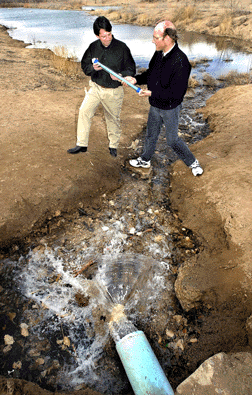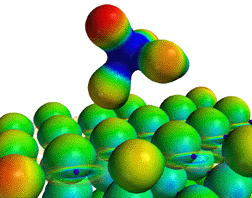|
Sandia arsenic-catchers could help communities supply safer drinking water affordably
|

WATER SANS ARSENIC — David Teter (left) and Pat Brady are members of a Sandia National Laboratories research team that developed new arsenic-getting materials they call Specific Anion Nanoengineered Sorbents (SANS). Groundwater flowing through a column of the SANS would have its arsenic content reduced to undetectable levels.� (Photo by Randy Montoya)
Download 300dpi JPEG image, ‘Arsenicwater.jpg’, 680K (Media are welcome to download/publish this image with related news stories.)
|
ALBUQUERQUE, N.M. — Sandia National Laboratories researchers have used supercomputers to design new chemicals with flypaper-like arsenic-trapping properties.
Successful trials of the inexpensive new materials may have national implications as hundreds of U.S. communities tally up the costs of reducing arsenic concentrations in water supplies. Regulations now being negotiated by the Environmental Protection Agency (EPA) are expected to sharply reduce the maximum allowed amount of arsenic in drinking water.
The Sandia developers hope to test the new materials, called Specific Anion Nanoengineered Sorbents (SANS), at a planned city water-purification demonstration plant in Albuquerque, as well as in several smaller water systems in rural New Mexico communities.
Water sans arsenic
Inorganic arsenic occurs naturally in some groundwater, seeping out of rock and soils that neighbor the aquifer. Ingestion of high levels of arsenic has been linked to a variety of cancers and cardiovascular and neurological illnesses, although scientific data linking low-level, chronic arsenic ingestion to health effects are limited.
The EPA is reviewing its current arsenic limit of 50 parts per billion and plans to establish a new limit that is at least 60 percent lower.
Depending on the new limit that results, the national price tag for complying with a new EPA standard could be in the billions to tens of billions of dollars. A U.S. Geological Survey study estimates that 14 percent of all U.S. water supplies provide drinking water with arsenic concentrations greater than 5 ppb, and 3 percent provide water that exceeds 20 ppb. Water supplies in the western U.S. were found to have some of the highest arsenic concentrations.
The Sandia developers think the new arsenic-getting SANS could reduce the sticker shock of removing arsenic from drinking water for cities served by water treatment plants, rural communities, and homes, schools, and apartment complexes served by single wells.
“We’ve zeroed in on a class of material that is affordable and obtainable and peculiarly selective for arsenic,” says Sandia researcher David Teter.
The demonstrations being planned in community water-supply systems will verify the SANS arsenic-removal effectiveness and cost estimates, he says.

Computer image of arsenate ion sorbing onto an oxide surface. The image is generated using a form of quantum mechanical modeling called density functional theory that examines the electrostatic potential surfaces of the two materials.�
Download 300dpi JPEG image, ‘sanssorb.jpg’, 424K (Media are welcome to download/publish this image with related news stories.)
|
|
Designing arsenic trappers
Most mineral “'getters” have negatively charged surfaces, so they repel anions (negatively charged atom groups). The SANS selectively attract dissolved anions such as arsenate (a toxic arsenic-containing compound) to positively charged sites on the SANS surfaces and grab hold.
To create the materials, the researchers selected mineral families with known affinities for anions, then used supercomputer modeling to rapidly simulate the arsenic-trapping aptitudes of thousands of combinations and variations of the minerals.
“We knew which classes of materials should be highly selective for arsenic at the atomic level,” says Sandia researcher Pat Brady, “so we asked ourselves what is peculiar or common about those materials. Then we tried to find or make other materials with similar properties.”
Because there are nearly infinite variations of chemical species, phases, and surface chemistries, the researchers let the computer sort out the very best performers.
“We got some big hits on materials that had never been considered before,” says Teter.
They ruled out those minerals that are difficult or expensive to obtain or produce, that would become saturated too quickly, or that would result in a hazardous byproduct.
They now are verifying the computers’ results in a lab, pumping arsenic-contaminated water through the powdered materials, then measuring the arsenic content of the outflow.
For proprietary reasons, the researchers can’t yet divulge what materials the team designed, but they generally are nontoxic mixed metal oxides with high molecular surface areas.
Useful new chemistries
At water treatment plants, groundwater could be pumped through columns containing the powdered materials. Arsenic content in the outflow would be reduced to undetectable levels. After perhaps years of use, the nonhazardous arsenic-saturated getters could be safely disposed of in landfills.
“Municipalities now filter out dirt, silt, and sewage, but pulling out stuff at the parts-per-billion range cheaply is a new and difficult challenge,” says Brady.
The SANS could be easily adapted for use with smaller water systems, even down to the individual well or household scale, says Teter.
In addition, the same research methodology used to identify the SANS for arsenic removal could be used to design getters for removing other micropollutants from drinking water, or purify industrial waste water, process streams, and other effluents, adds Teter.
The SANS work is part of a larger Sandia water initiative that seeks technical solutions to national water issues — including threats to water-distribution systems, geopolitical stresses relating to water scarcity, and economic concerns associated with supplying drinkable water.
Sandia is a multiprogram Department of Energy laboratory operated by Lockheed Martin Corp. With main facilities in Albuquerque and Livermore, Calif., Sandia has R&D programs contributing to national security, energy and environment, and U.S. economic competitiveness.
Sandia is a multiprogram laboratory operated by Sandia Corporation, a Lockheed Martin Company, for the United States Department of Energy under contract DE-AC04-94AL85000. With main facilities in Albuquerque, N.M., and Livermore, Calif., Sandia has major research and development responsibilities in national security, energy and environmental technologies, and economic competitiveness.
Sandia media contact:
John German, jdgerma@sandia.gov, (505) 844-5199
Other resources:
Arsenic toxicity:
http://www.bicn.com/acic/resources/arsenic-on-the-www/articles-refmat.htm#toxic
EPA list of current arsenic-removal technologies:
http://www.epa.gov/OGWDW/ars/trtmt.html
USGS water supply studies:
http://co.water.usgs.gov/trace/arsenic/
City of Albuquerque’s Arsenic Removal Demonstration Plant:
http://www.cabq.gov/waterquality/arsenic.html
Related Sandia news releases:
http://www.sandia.gov/media/NewsRel/NR2000/arsenic.htm
http://www.sandia.gov/media/NewsRel/NR2001/soms.htm
| 